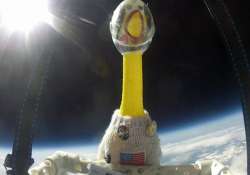Rubber chicken sent to space by US school students
Los Angeles, Apr 23: Students of Bishop Union High School in California last month sent a rubber chicken to space to study a solar storm. The bird, called Camilla, was attached to a helium balloon

Los Angeles, Apr 23: Students of Bishop Union High School in California last month sent a rubber chicken to space to study a solar storm.
The bird, called Camilla, was attached to a helium balloon and sent to an altitude of 120,000ft to test the levels of radiation in one of the strongest proton storms in years, reportsw Daily Mail.
It was the second time she has been sent to space.
Rachel Molina, 17, told NASA: ‘Later this year, we plan to launch a species of microbes to find out if they can live at the edge of space.'
Camilla is the mascot of NASA's Solar Dynamics Observatory and has more than 20,000 followers of Twitter, Facebook and Google+.
Romeo Durscher, of Stanford University, said: ‘Camilla's trip to the stratosphere gave us a chance to talk to thousands of people about the radiation storm.'
During the two-and-a-half-hour flight, Camilla spent about 90 minutes in the stratosphere where temperatures and air pressures are like those on the planet Mars.
On the outside of her specially knitted space suit, she wore a pair of radiation badges - the same kind worn by medical technicians and nuclear workers.
The source of the radiation unleashed more than 50 solar flares during the first two weeks of March.
At the peak of the storm, from March 7 to March 10, charged particles hitting Earth's upper atmosphere deposited enough heat in only three days to power every residence in New York City for two years, according to NASA.
After the mission, the balloon popped as planned and Camilla parachuted safely back to Earth.
She was recovered intact from a landing site in the Inyo Mountains.
Her spacecraft - a modified department store lunchbox, carried four cameras, a cryogenic thermometer and two GPS trackers.
Seven insects and two dozen sunflower seeds also rode along to test their response to near-space travel.
The insects did not the survive the trip and have been exhibited on a black ‘Foamboard of Death' in the school to showcase bugs that have been to space.
Meanwhile, Camilla's radiation badges have been sent to a laboratory for analysis.
A solar radiation storm is a blast of radiation from the Sun towards the Earth, made up of protons and other charged particles.
The radiation is blocked by the magnetosphere and atmosphere, so cannot reach humans on Earth.
Such a storm could, however, harm humans traveling from Earth to the Moon or Mars, though it has little to no effect on aeroplane passengers or astronauts within Earth's magnetosphere.
The bird, called Camilla, was attached to a helium balloon and sent to an altitude of 120,000ft to test the levels of radiation in one of the strongest proton storms in years, reportsw Daily Mail.
It was the second time she has been sent to space.
Rachel Molina, 17, told NASA: ‘Later this year, we plan to launch a species of microbes to find out if they can live at the edge of space.'
Camilla is the mascot of NASA's Solar Dynamics Observatory and has more than 20,000 followers of Twitter, Facebook and Google+.
Romeo Durscher, of Stanford University, said: ‘Camilla's trip to the stratosphere gave us a chance to talk to thousands of people about the radiation storm.'
During the two-and-a-half-hour flight, Camilla spent about 90 minutes in the stratosphere where temperatures and air pressures are like those on the planet Mars.
On the outside of her specially knitted space suit, she wore a pair of radiation badges - the same kind worn by medical technicians and nuclear workers.
The source of the radiation unleashed more than 50 solar flares during the first two weeks of March.
At the peak of the storm, from March 7 to March 10, charged particles hitting Earth's upper atmosphere deposited enough heat in only three days to power every residence in New York City for two years, according to NASA.
After the mission, the balloon popped as planned and Camilla parachuted safely back to Earth.
She was recovered intact from a landing site in the Inyo Mountains.
Her spacecraft - a modified department store lunchbox, carried four cameras, a cryogenic thermometer and two GPS trackers.
Seven insects and two dozen sunflower seeds also rode along to test their response to near-space travel.
The insects did not the survive the trip and have been exhibited on a black ‘Foamboard of Death' in the school to showcase bugs that have been to space.
Meanwhile, Camilla's radiation badges have been sent to a laboratory for analysis.
A solar radiation storm is a blast of radiation from the Sun towards the Earth, made up of protons and other charged particles.
The radiation is blocked by the magnetosphere and atmosphere, so cannot reach humans on Earth.
Such a storm could, however, harm humans traveling from Earth to the Moon or Mars, though it has little to no effect on aeroplane passengers or astronauts within Earth's magnetosphere.